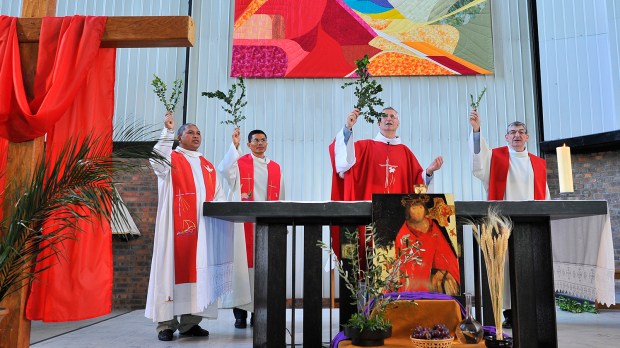Palm Sunday of the Lord’s Passion marks the beginning of Holy Week, the final week of preparation before the feast of Easter. In the Roman Rite, the celebration of Mass has particular traditions that make it look much different than a typical Sunday Mass.
Many of these traditions are centuries old, having roots in the early Church, based on the events that occur in the Gospel passages.
The differences are meant to enrich our celebration of Jesus’ Passion, immersing us into the events in a unique way to help our souls ponder the beauty and riches of the Paschal mystery.
Here are 7 of these traditions and the symbolism behind them.
Please click on the title link for more information.
Why does Mass begin with a procession?
Besides imitating Jesus’ procession into Jerusalem, the sanctuary of the church is naturally a place that symbolize heaven, with the presence of Jesus in the Eucharist.
Furthermore, often the sanctuary is elevated by a number of steps. This too has symbolism, lifting up our eyes (and hearts) to God, but also reminding us of Jesus’ ascent to Mount Calvary. The priest assumes this role and ascends to a “mystical” Mount Calvary to offer the sacrifice of the Mass, participating in the one sacrifice of Jesus on the cross.
Why palms or other plants are used for the procession
Biblical scholars often translate the branches people used for Jesus’ triumphal entry in generic terms, such as in the Gospel of Matthew, “The very large crowd spread their cloaks on the road, while others cut branches from the trees and strewed them on the road” (Matthew 21:8).
In essence, when palm branches are not available, it is perfectly acceptable to find any type of suitable branch to help commemorate Palm Sunday.
The branches are meant to be a symbolic gesture, symbolizing the need to lay down our hearts before Jesus, allowing him access into our inmost being. This is why, even if you don’t have branches of any sort for your celebration, you can still participate in the spiritual theme of Palm Sunday.
Why does the priest wear red?
Red is the color of blood and symbolizes love, fire, passion, and the blood of sacrifice. Red is worn on Palm Sunday, Good Friday, any day related to Jesus’ Passion, on Pentecost and on the feast days of those who died for the faith (martyrs).
Why are statues and images veiled?
It seems strange that during the most sacred time of year Catholics cover everything that is beautiful in their churches, even the crucifix. Shouldn’t we be looking at the painful scene at Calvary while we listen to the Passion narrative on Palm Sunday?
While it may appear counterintuitive to veil statues and images during the final weeks of Lent, the Catholic Church recommends this practice to heighten our senses and build within us a longing for Easter Sunday. It is a tradition that should not only be carried out in our local parish, but can also be a fruitful activity for the “domestic church” to practice.
Why is the Gospel reading so long?
For Roman Catholics, the weekly Sunday Mass readings are extremely short when compared to the Passion narrative that is recited (or sung) every year on Palm Sunday. This makes Palm Sunday somewhat difficult to attend for those who have trouble standing for the entire Gospel proclamation.
However, did you know that every Sunday may have been like that in the early Church?
Many of the first Christians were Jewish, and so, not surprisingly, they modeled their liturgy on the synagogue services. This included a continuous reading of Sacred Scripture that was carried on from one week to the next. It was divided up into two separate readings, one from the “Law” and the other from the “Prophets.”
Why does the congregation participate in the Passion reading?
Holy Week is the most sacred time in the Church’s liturgical calendar, entirely focused on Jesus’ Passion, death, and resurrection. A recurrent theme throughout the week is a call to accompany Jesus during this most painful part of his life on earth.
Palm Sunday opens Holy Week with a solemn recitation of Jesus’ Passion, and typically this involves each person having a role. When celebrated in a church, the parishioners often take the role of the crowd. This culminates in the entire congregation saying, “Crucify him! Crucify him!” In this instance we recognize the role our sins have in Jesus’ crucifixion and how Jesus suffered and died for us, even though we weren’t even born yet.
What should I do with my blessed palms?
After leaving church on Sunday, you may have come home with several long palm branches from the celebration of Jesus’ triumphant entry into Jerusalem.
You may be asking yourself, “Well, what should I do with these?”
Whatever you do, don’t throw them away!
According to the Code of Canon Law, blessed items are not to be discarded in a trash can, but treated with respect (cf. #1171). At Mass these palm branches were set apart by a blessing from the priest and made into a “sacramental,” an object that is meant to draw us closer to the celebration of the seven sacraments. Throwing them in the trash ignores their sacred purpose and treats them like any other object we no longer need.

Read more:
In images: Holy Week around the world

